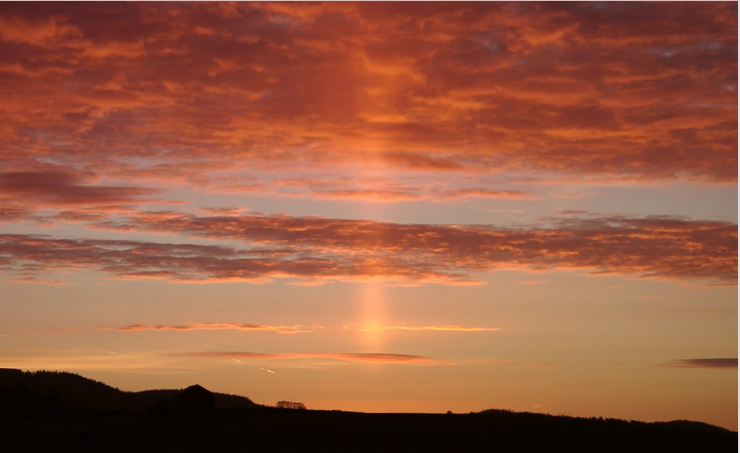Sun pillar
Sun Pillar: A Phenomenon of Atmospheric Optics
Have you ever gazed at the sky during sunrise or sunset and noticed a stunning vertical beam of light extending upwards from the sun? This captivating sight is known as a sun pillar. Sun pillars are a fascinating atmospheric optical phenomenon that occurs when sunlight interacts with ice crystals in the atmosphere, creating a pillar-like column of light. In this article, we will delve deeper into the science behind sun pillars, exploring their formation, characteristics, and the conditions necessary for their occurrence.
Formation of Sun Pillars
Sun pillars are formed when sunlight reflects off horizontally oriented ice crystals suspended in the Earth's atmosphere. These ice crystals can be found in various types of clouds, such as cirrus clouds, which are composed of thin, wispy strands of ice crystals at high altitudes. When the sun is low on the horizon during sunrise or sunset, its light passes through a larger portion of the atmosphere, increasing the chances of interaction with these ice crystals.
Characteristics of Sun Pillars
Sun pillars typically appear as vertical columns of light extending upwards from the sun. The height of a sun pillar depends on the altitude at which the ice crystals are present. The colors of a sun pillar are often similar to those seen during sunrise or sunset, ranging from warm oranges and reds to vibrant pinks and purples. This coloration is due to the scattering of sunlight by the Earth's atmosphere, which causes shorter wavelengths (blue and green) to disperse more, leaving behind longer wavelengths (red and orange).
Optical Illusion
Although sun pillars may appear as solid beams of light reaching towards the heavens, they are actually optical illusions created by the interaction of light with ice crystals. The vertical alignment of the ice crystals causes the reflected light to appear as a vertical column. This phenomenon is similar to how light passing through a prism is separated into different colors, creating a rainbow.
Conditions for Sun Pillar Formation
Several conditions must align for a sun pillar to form. Firstly, there must be a sufficient presence of ice crystals in the atmosphere, typically found in high-altitude clouds like cirrus clouds. Secondly, the sun must be relatively low on the horizon during sunrise or sunset. This positioning allows the sunlight to pass through a larger portion of the atmosphere, increasing the likelihood of interaction with the ice crystals. Lastly, the ice crystals must be horizontally oriented to reflect the sunlight vertically, creating the pillar-like effect.
Variations of Sun Pillars
While the classic sun pillar appears as a single vertical beam of light, variations of this phenomenon can also occur. Multiple pillars can sometimes be seen, forming a stunning display resembling a ladder or a curtain of light. These variations occur when there are multiple layers of ice crystals at different altitudes, each reflecting sunlight in its own unique way.
Capturing the Beauty of Sun Pillars
Sun pillars are truly mesmerizing sights that captivate both professional and amateur photographers alike. To capture the beauty of a sun pillar, one must position themselves in an open area with an unobstructed view of the horizon during sunrise or sunset. The use of a polarizing filter can help enhance the colors and contrast of the pillar in photographs.
Conclusion
Sun pillars are awe-inspiring phenomena of atmospheric optics that add a touch of magic to our skies. These vertical columns of light, formed by the reflection of sunlight off ice crystals in the atmosphere, create captivating displays during sunrise and sunset. Understanding the science behind sun pillars allows us to appreciate the beauty and complexity of our natural world. So, next time you find yourself witnessing a sun pillar, take a moment to marvel at this extraordinary play of light and ice in the sky.

Sunrise sun pillar County Durham, England. Sunlight reflected off ice crystals in a high cirrus haze produce the pillar whilst rays reddened by a long passage though the atmosphere light the lower clouds. Imaged by Dave Liquorice (site) on 5th November 2001 when the sun was just below the horizon. ©Dave Liquorice, shown with permission.
Note: this article has been automatically converted from the old site and may not appear as intended. You can find the original article here.
Reference Atmospheric Optics
If you use any of the definitions, information, or data presented on Atmospheric Optics, please copy the link or reference below to properly credit us as the reference source. Thank you!
-
<a href="https://atoptics.co.uk/blog/sun-pillar/">Sun pillar</a>
-
"Sun pillar". Atmospheric Optics. Accessed on December 25, 2024. https://atoptics.co.uk/blog/sun-pillar/.
-
"Sun pillar". Atmospheric Optics, https://atoptics.co.uk/blog/sun-pillar/. Accessed 25 December, 2024
-
Sun pillar. Atmospheric Optics. Retrieved from https://atoptics.co.uk/blog/sun-pillar/.